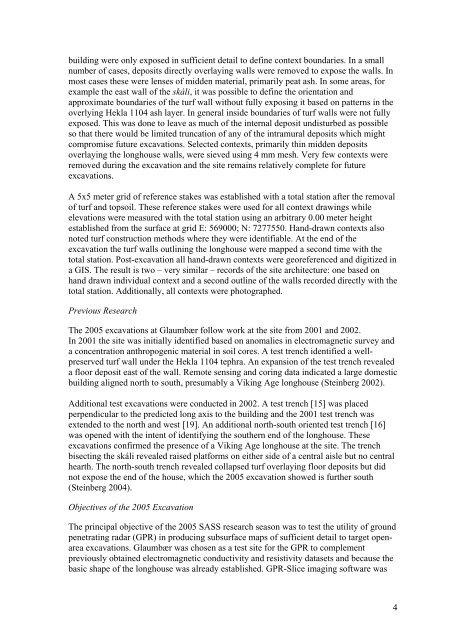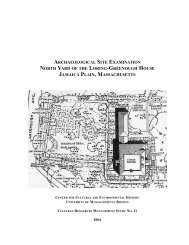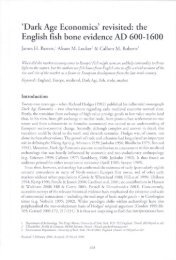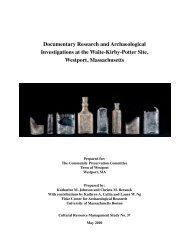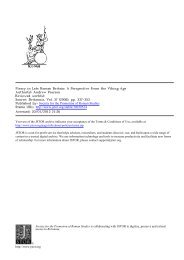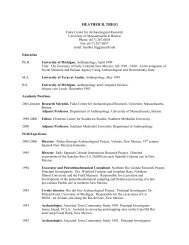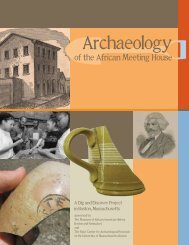Excavations at Glaumbær - Fiske Center
Excavations at Glaumbær - Fiske Center
Excavations at Glaumbær - Fiske Center
Create successful ePaper yourself
Turn your PDF publications into a flip-book with our unique Google optimized e-Paper software.
uilding were only exposed in sufficient detail to define context boundaries. In a small<br />
number of cases, deposits directly overlaying walls were removed to expose the walls. In<br />
most cases these were lenses of midden m<strong>at</strong>erial, primarily pe<strong>at</strong> ash. In some areas, for<br />
example the east wall of the skáli, it was possible to define the orient<strong>at</strong>ion and<br />
approxim<strong>at</strong>e boundaries of the turf wall without fully exposing it based on p<strong>at</strong>terns in the<br />
overlying Hekla 1104 ash layer. In general inside boundaries of turf walls were not fully<br />
exposed. This was done to leave as much of the internal deposit undisturbed as possible<br />
so th<strong>at</strong> there would be limited trunc<strong>at</strong>ion of any of the intramural deposits which might<br />
compromise future excav<strong>at</strong>ions. Selected contexts, primarily thin midden deposits<br />
overlaying the longhouse walls, were sieved using 4 mm mesh. Very few contexts were<br />
removed during the excav<strong>at</strong>ion and the site remains rel<strong>at</strong>ively complete for future<br />
excav<strong>at</strong>ions.<br />
A 5x5 meter grid of reference stakes was established with a total st<strong>at</strong>ion after the removal<br />
of turf and topsoil. These reference stakes were used for all context drawings while<br />
elev<strong>at</strong>ions were measured with the total st<strong>at</strong>ion using an arbitrary 0.00 meter height<br />
established from the surface <strong>at</strong> grid E: 569000; N: 7277550. Hand-drawn contexts also<br />
noted turf construction methods where they were identifiable. At the end of the<br />
excav<strong>at</strong>ion the turf walls outlining the longhouse were mapped a second time with the<br />
total st<strong>at</strong>ion. Post-excav<strong>at</strong>ion all hand-drawn contexts were georeferenced and digitized in<br />
a GIS. The result is two – very similar – records of the site architecture: one based on<br />
hand drawn individual context and a second outline of the walls recorded directly with the<br />
total st<strong>at</strong>ion. Additionally, all contexts were photographed.<br />
Previous Research<br />
The 2005 excav<strong>at</strong>ions <strong>at</strong> <strong>Glaumbær</strong> follow work <strong>at</strong> the site from 2001 and 2002.<br />
In 2001 the site was initially identified based on anomalies in electromagnetic survey and<br />
a concentr<strong>at</strong>ion anthropogenic m<strong>at</strong>erial in soil cores. A test trench identified a wellpreserved<br />
turf wall under the Hekla 1104 tephra. An expansion of the test trench revealed<br />
a floor deposit east of the wall. Remote sensing and coring d<strong>at</strong>a indic<strong>at</strong>ed a large domestic<br />
building aligned north to south, presumably a Viking Age longhouse (Steinberg 2002).<br />
Additional test excav<strong>at</strong>ions were conducted in 2002. A test trench [15] was placed<br />
perpendicular to the predicted long axis to the building and the 2001 test trench was<br />
extended to the north and west [19]. An additional north-south oriented test trench [16]<br />
was opened with the intent of identifying the southern end of the longhouse. These<br />
excav<strong>at</strong>ions confirmed the presence of a Viking Age longhouse <strong>at</strong> the site. The trench<br />
bisecting the skáli revealed raised pl<strong>at</strong>forms on either side of a central aisle but no central<br />
hearth. The north-south trench revealed collapsed turf overlaying floor deposits but did<br />
not expose the end of the house, which the 2005 excav<strong>at</strong>ion showed is further south<br />
(Steinberg 2004).<br />
Objectives of the 2005 Excav<strong>at</strong>ion<br />
The principal objective of the 2005 SASS research season was to test the utility of ground<br />
penetr<strong>at</strong>ing radar (GPR) in producing subsurface maps of sufficient detail to target openarea<br />
excav<strong>at</strong>ions. <strong>Glaumbær</strong> was chosen as a test site for the GPR to complement<br />
previously obtained electromagnetic conductivity and resistivity d<strong>at</strong>asets and because the<br />
basic shape of the longhouse was already established. GPR-Slice imaging software was<br />
4


